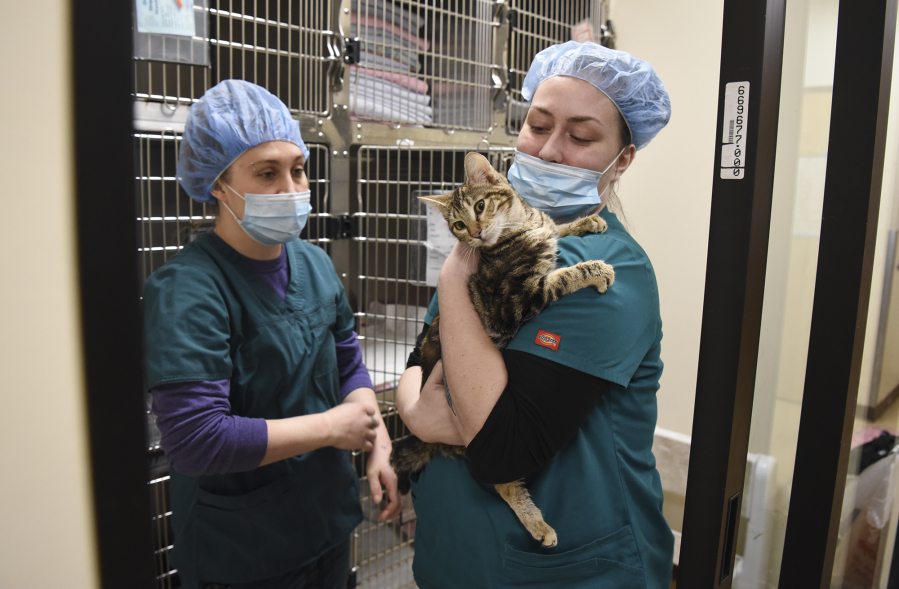At the Humane Society for Southwest Washington, veterinary assistants clad in green scrubs finished shaving the lower belly of Autumn, a 2-year-old long hair domestic cat. She’d been thoroughly anesthetized and was ready for an operation that the animal welfare organization is hoping to perform on cats with more tenuous connections to humans.
After her shaved area was disinfected, Kristi Ellis, the clinic’s lead veterinarian, used a scalpel to cut a small incision to remove Autumn’s uterus and ovaries.
“This cat, for what it’s worth, is in heat,” Ellis said before she snipped the organs and sutured the incision. Before turning her attention to the next cat, Ellis tattooed a green line on Autumn’s belly indicating that she had been spayed.
That morning, workers at the Humane Society sterilized with assembly-line-like efficiency about 30 cats belonging to low-income individuals who might not be able to pay the hundreds of dollars veterinarians normally charge. Lisa Feder, vice president of shelter operations for the Humane Society, credits efforts like these with helping reduce the area’s population of stray and unwanted cats in recent years.
Now, the Humane Society is hoping to expand these efforts to feral cats, an unwieldy population that Paul Scarpelli, county animal protection and control manager, said he deals with daily.
Feder said that sterilizing more of the county’s roughly estimated 60,000 to 70,000 feral cats will keep their population in check. Doing so will require a change in the county’s animal control code, which doesn’t account for situations where a cat might rely on a few different people (or none at all) for food, to allow these animals to be released after being sterilized.
But the Feral Cat Coalition of Oregon and Audubon Society of Portland have raised concerns that the policy will send the wrong message to the public about caring for cats and could have unintended consequences, particularly for wildlife.
“When you push on one piece of that puzzle, it can affect other parts of the puzzle,” said Bob Sallinger, conservation director for the Audubon Society of Portland.
Live and let live?
In 2006, nine animal shelters and welfare organizations from the Portland metropolitan area, including the Humane Society for Southwest Washington, formed the Animal Shelter Alliance of Portland. The alliance was formed so that the organizations could share information and resources with the goal of euthanizing fewer healthy and adoptable dogs and cats.
Since then, the alliance has reduced euthanasia in its shelters by 89 percent. In Clark County last year, the Humane Society euthanized 360 cats because they were too sick or injured to survive. That compares to 5,789 cats it put down in 2006.
Feder said that last year her organization took in 2,163 stray cats, a 7 percent reduction from the previous year. In the last seven years, she said, she’s seen a roughly 15 percent reduction in intake.
“We believe that the decrease in stray cats is due to just the volume of spay and neuter we’ve been able to accomplish,” she said.
But Feder said feral cats remain a challenge. Even if healthy, feral cats are rarely adoptable because they are so unaccustomed to living with humans, she said.
She said there’s a unique legal obstacle to sterilizing and vaccinating feral cats, or at least neighborhood cats that may not have a clear owner. Feder explained that if a feral cat is brought to the Humane Society, either by animal control officers or a concerned resident, the feline will be vaccinated and sterilized. But she said local animal control laws still require the cat to be returned to its owner or adopted. Returning the cat to where it was found would be considered abandonment, which is illegal. Thus, a cat with no owner effectively becomes the Humane Society’s.
“The problem is there are very, very few sanctuaries or rescues that take feral cats,” said Stacey Graham, president of the Humane Society for Southwest Washington. “We’re a shelter; we don’t keep cats forever.”
In December, the city of Vancouver updated its code to recognize free-roaming cats with nebulous, if any, connections to humans. The code change created a “community cat program” allowing these cats to be sterilized, vaccinated and returned to where they were found.
“Those cats could go back to where they’re living and pick back up where they left off,” said Feder, except that they won’t produce feral kittens. More sterilized cats mean the feral population will steadily decline.
Cat fight
Clark County is expected to consider similar code revisions this spring, and two Portland-based groups, which stress that they have a good relationship with the Humane Society, have expressed concern.
“While (the Feral Cat Coalition of Oregon) is supportive of saving cats’ lives, we are not supportive of abandoning cats back into the landscape without a known food source,” reads a letter that Karen Kraus, executive director of the FCCO, sent last month to the Humane Society. “We are deeply concerned about the message this sends the community: cats will be fine when left on their own.”
The letter, which was forwarded to the Clark County council, asked that instead more resources and outreach be directed toward raising awareness about feral cats.
Kraus told The Columbian that managing feral cats requires a more active approach than what’s being proposed. She said entire colonies of cats should be trapped, vaccinated, sterilized and released to ensure their populations decline.
Sallinger, of the Audubon Society of Portland, has raised concerns that outdoor cats reduce bird populations. He said that 40 percent of the birds in his shelter have been attacked by cats, and he is worried the policy could impact wildlife populations.
Katie Lisnik, director of cat protection and policy for the Humane Society of the United States, said that the proactive approach of trapping, sterilizing and releasing feral cats originated in Britain decades ago. She said similar approaches have since then been adopted in communities across the U.S.
Some communities take a less active approach, only sterilizing and returning feral cats that are brought to shelters, she said. Lisnik said that these populations need to be actively managed and that 75 percent of a feral cat population needs to be sterilized to see its population decline.
“Nature is going to fill a vacuum,” she said.
Feder said that education and outreach regarding feral cats have always been part of the Humane Society’s strategy for dealing with feral cats. She said her organization will work with property owners who have colonies of cats.
Feder said that if the county makes code changes similar to Vancouver, her organization could vaccinate, sterilize and release up to 150 cats with tenuous ties to humans each year. She said that’s a small number, but being allowed to release feral cats after sterilizing them is just one part of their long-term strategy.
“Releasing cats back into the community has always been one piece of a very big puzzle that we have been putting together for the last several years,” said Feder.
County councilors contacted by The Columbian either didn’t respond to a request for comment or hadn’t reviewed the proposed changes. Councilor Julie Olson, however, said the proposal from the Humane Society made sense.
As for the disagreement between the groups, she said, “They have the same noble goal in mind.”




